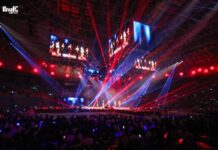
This set of movable metal type was used to print the Neungeomgyeongeonhae(楞嚴經諺解) Buddhist scriptures in 1461.
The ancient Korean kingdom of Joseon (1392-1910) is known as “a kingdom of type printing.”
The countless number of records printed with movable type backs up this claim, from the “Annals of the Joseon Dynasty,” or “Joseon Wangjosillok” (조선왕조실록, 朝鮮王朝實錄), which recorded the times and reign of every Joseon monarch for 425 years, through to the “Seungjeongwon Ilgi” (승정원일기, 承政院日記), a journal of the royal secretariat. There’s also the “Ilseongnok” (일성록, 日省錄), the daily records kept of the monarchy’s and the king’s acts at court from 1792 to 1910.
Starting with the first-ever Joseon system of movable metal type, called the gyemija (계미자, 癸未字), created in 1403 by the third Joseon monarch Taejong, the subsequent Joseon monarchs continued to cast millions of such printing metal types throughout the existence of the dynasty.

A set of movable copper type, the imjinja (임진자, 壬辰字), was cast in 1772 during Joseon times.

King Jeongjo cast a set of movable copper type, called the jeongrija, in 1796.
To bring the art of Joseon type printing back to life, the National Museum of Korea kicked off a special exhibition on June 21, “Joseon: The Movable Type Dynasty.” The exhibition showcases approximately 820,000 type blocks, including about 30 metal type blocks cast in the 1400s, 320,000 wooden type blocks imported from China, and more than 500,000 metal type blocks produced between the 1600s to the 1900s.
Among these exhibits, in particular, there is a set of wooden type blocks that King Jeongjo (1752-1800), the 22nd Joseon monarch, imported from China in 1790 and 1791 for reference in making his own copper type, thejeongrija (정리자, 整理字) that consisted of a total of 300,000 type blocks. This wooden type is believed to be the oldest among Chinese printing types of this kind.
Exhibits here are arranged into two sections in a way that can help exhibition-goers easily understand the significance of the production and the use of movable printing type during Joseon times. A wide range of Joseon metal type is put under the spotlight, while a set of cabinets and drawers for type storage surrounds the central exhibit.

King Jeongjo had wooden printing type imported from China for reference in making the jeongrija copper type in 1796.

Movable metal type was categorized and stored in a specially designed cabinet in the 1600s.

This drawer is part of a cabinet designed to classify and store jeongrija, a set of movable copper type cast in 1796 during the reign of King Jeongjo.
The highlight of the exhibit is a large showcase, 8 meters by 1.5 meters, located at the heart of the museum that contains about 55,000 small movable type blocks. This artifact alone garners more interest than the other examples of ancient movable type.
Visual materials — video clips that trace the restoration process of a set of movable printing type, video games that allow people to understand Chinese characters formed with metal type, and, lastly, replicas of type blocks created by a 3-D printer — help visitors to easily understand the Joseon tradition of using metal printing.
“Joseon rulers led efforts to produce movable metal type for their records, which is one of the distinctive traditions that existed in Joseon times,” said Lee Jae-jeong, a researcher at the National Museum of Korea. “Hopefully, this exhibition will help people realize how many sets of movable printing type were produced back then, as well as how outstanding type production techniques were, and the beauty of prints with movable type.”

‘Joseon: The Movable Type Dynasty’ continues until Sept. 11 at the National Museum of Korea.
By Sohn JiAe
Korea.net Staff Writer
Photos: The National Museum of Korea
jiae5853@korea.kr























